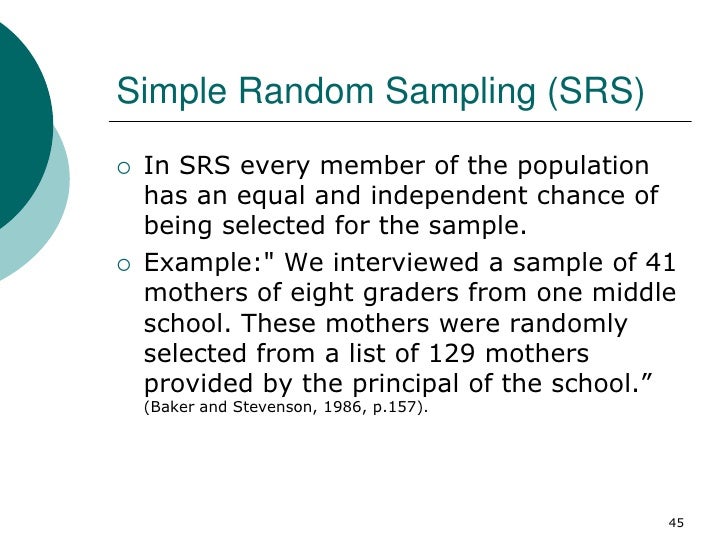
INTRODUCTION
· 1. Simple random sampling. In a simple random sample, every member of the population has an equal chance of being selected. Your sampling frame should include the whole population. To conduct this type of sampling, you can use tools like random number generators or other techniques that are based entirely on chance To set the sampling strategy that you will use in your dissertation, you need to follow three steps: (a) understand the key terms and basic principles; (b) determine which sampling technique you will use to select the units that will make up your sample; and (c) consider the practicalities of choosing such a sampling strategy for your dissertation (e.g., what time you have available, To create a systemic random sample, there are seven steps: (a) defining the population; (b) choosing your sample size; (c) listing the population; (d) assigning numbers to cases; (e) calculating the sampling fraction; (f) selecting the first unit; and (g) selecting your sample. STEP ONE: Define the population

Table of contents
Dissertations that draw on a post-positivist research paradigm, a quantitative research design and a questionnaire as their research method would ideally use a probability sampling technique (e.g., simple random sampling, systematic random sampling, stratified random sampling). By contrast, dissertations that draw on a constructivist research paradigm, a qualitative research About 66 item dissertation in line with Random sampling query results,the following is 1 to 50(Search took seconds) Research on Filtering and Control for Networked Discrete-time Systems Based on Markov Chain, XuYong/Zhejiang University,0/13; The Research of Image Splicing Technology Based on Fish-eye, LiCui/Tianjin University of · 1. Simple random sampling. In a simple random sample, every member of the population has an equal chance of being selected. Your sampling frame should include the whole population. To conduct this type of sampling, you can use tools like random number generators or other techniques that are based entirely on chance

Sampling strategy
Dissertations that draw on a post-positivist research paradigm, a quantitative research design and a questionnaire as their research method would ideally use a probability sampling technique (e.g., simple random sampling, systematic random sampling, stratified random sampling). By contrast, dissertations that draw on a constructivist research paradigm, a qualitative research To create a systemic random sample, there are seven steps: (a) defining the population; (b) choosing your sample size; (c) listing the population; (d) assigning numbers to cases; (e) calculating the sampling fraction; (f) selecting the first unit; and (g) selecting your sample. STEP ONE: Define the population To set the sampling strategy that you will use in your dissertation, you need to follow three steps: (a) understand the key terms and basic principles; (b) determine which sampling technique you will use to select the units that will make up your sample; and (c) consider the practicalities of choosing such a sampling strategy for your dissertation (e.g., what time you have available,

When to use simple random sampling
To create a stratified random sample, there are seven steps: (a) defining the population; (b) choosing the relevant stratification; (c) listing the population; (d) listing the population according to the chosen stratification; (e) choosing your sample size; (f) calculating a proportionate stratification; and (g) using a simple random or systematic sample to select your sample · Simple random sampling: in this case, we have a full list of sample units or participants (sample basis), and we randomly select individuals using a table of random numbers. An example is the study by Pimenta et al, in which the authors obtained a listing from the Health Department of all elderly enrolled in the Family Health Strategy and, by simple random To set the sampling strategy that you will use in your dissertation, you need to follow three steps: (a) understand the key terms and basic principles; (b) determine which sampling technique you will use to select the units that will make up your sample; and (c) consider the practicalities of choosing such a sampling strategy for your dissertation (e.g., what time you have available,

Stratified random sampling
· 1. Simple random sampling. In a simple random sample, every member of the population has an equal chance of being selected. Your sampling frame should include the whole population. To conduct this type of sampling, you can use tools like random number generators or other techniques that are based entirely on chance · Simple random sampling: in this case, we have a full list of sample units or participants (sample basis), and we randomly select individuals using a table of random numbers. An example is the study by Pimenta et al, in which the authors obtained a listing from the Health Department of all elderly enrolled in the Family Health Strategy and, by simple random To create a stratified random sample, there are seven steps: (a) defining the population; (b) choosing the relevant stratification; (c) listing the population; (d) listing the population according to the chosen stratification; (e) choosing your sample size; (f) calculating a proportionate stratification; and (g) using a simple random or systematic sample to select your sample
No comments:
Post a Comment